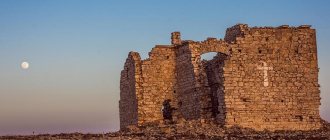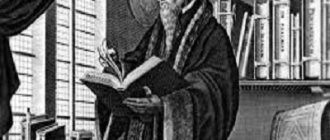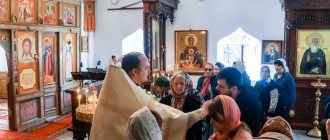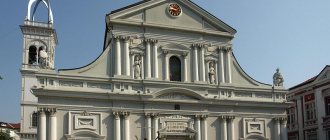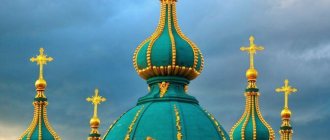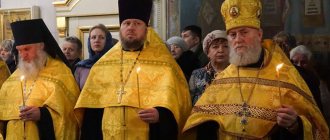The diocesan bishop is the head of a separate Christian community. He is also called the bishop. In ancient times such people were the senior companions of the followers of Christ. Along with the apostles, they helped Christianity to establish itself while the world was being reborn. If traveling preachers carried the Word of God to other nations, then bishops helped it to germinate in places where they had already sown the seed of the Good News. What is the role of the diocesan bishop in the Russian Orthodox Church today? Let's talk about it!
The first Christian bishop is called the Apostle James, the brother of the Lord
The first Christian bishop is often called the Apostle James. This is not Jacob of Zebedee, but Jacob the brother of the Lord. There is practically no debate about the historicity of this man, because Josephus mentioned him in his writings.
According to legend, the Apostle James of the 70s is the first Christian bishop
Clement writes that Peter and John chose James as bishop of Jerusalem. Researchers suggest that this happened around 34. The Apostle James was the chairman at the first Jerusalem Council (approximately 48–50 AD)
Jacob
first bishop of Jerusalem. Chosen by Peter and John in 48-50
Tradition describes Jacob as an ascetic and ascetic, equally respected by both Christians and Jews.
The bishopric of the Apostle James lasted approximately 30 years, and around the year 64, his enemies threw him from the wing of the Jerusalem Temple and stoned him. The apostle is credited with two religious texts - canonical and apocryphal - as well as the composition of the liturgy of the Apostle James.
Behavior in the presence of a bishop
Church etiquette is something every Orthodox Christian should know.
This is interesting! Church incense: what is it and what does it smell like?
Getting to the celebration,
buffet or dinner party, you need to remember how to behave and follow the following rules:
- When you arrive at the reception, you need to come up for a personal blessing by clergy. A person who is not a member of the church can greet the clergyman with a normal handshake.
- The meal begins with common prayer. Persons of other religions must remain silent during prayer.
- You are allowed to make toasts in honor of anyone present; you must end your message with the words: “Many years to come!”
- Being late for an event for no reason is considered an insult, so it is better to plan all your time in advance. People belonging to the lowest hierarchical level are the first to arrive at the reception, and they are the last to leave.
- It is indecent to linger and drink excessive amounts of alcohol during a meal. Getting up from the table earlier than expected is also not recommended.
- Throughout the entire event, you should pay attention to the person sitting next to you, especially if it is a woman, but it is not customary to introduce yourself at the table.
- It is not recommended to talk with your mouth full, or to put a large amount of food on your plate.
- Free behavior, loud conversations, laughter and indecent conversations are not allowed at meals.
- It is not approved for a woman to appear in a short skirt, low-necked blouse or pants, although it is not necessary to wear a headscarf.
- When attending an event with the participation of sacred persons, it is better to observe moderation in everything.
By the III–IV centuries. the position of diocesan bishop was formed - a bishop at the head of the diocese
In the 2nd–3rd centuries. the function of the bishop in Christianity acquires greater clarity. At least that's how it looks today, through the centuries. Sources clearly describe what a bishop is - this is a hierarchical degree of clergy that heads the spiritual institution that governs the diocese. A priest of this level governs the Church, instructs others and performs the sacraments. He is also the chairman of the Councils. We know for sure that there should have been only one bishop in each Church.
About the bishop of the first centuries we can highlight the following information:
- He is chosen by the people according to the will of the Holy Spirit.
- A bishop cannot be married.
- The candidate is at least 50 years old.
- The bishop protects the Church from schisms.
- He is the representative of Christ.
Finally, over time, dioceses are established. A diocese is an ecclesiastical administrative-territorial unit governed by a bishop. It does not necessarily coincide territorially with the urban community and can unite several such areas. Or, on the contrary, the region can be divided into separate dioceses.
Varieties of bishops appear:
- Ruling Bishop,
- Vicar, that is, a bishop without territory. He performs the functions of a bishop (liturgical, teaching, etc.), but is subordinate to the ruling bishop.
Note: it is not always possible to equate the concepts of diocesan bishop and bishop.
Bishop is a spiritual rank. It does not necessarily imply the management of any diocese, although most often bishops are engaged in this activity.
A diocesan bishop is, rather, a position, an occupation. Anyone who is appointed to it must first be consecrated as a bishop.
By III–IV, the connection between the churches becomes closer, so the bishop is no longer the most important position. United district dioceses—metropolises—emerged. Their heads are metropolitans. During the same period, the basic church regulations and principles of the church hierarchy were finally formed.
Orders of clergy
Every Orthodox Christian, meeting representatives of the clergy, understands that there are certain differences in their rank. The criteria include hats, clothing, the presence of jewelry, precious stones, and others. To better understand who a bishop is, let’s consider what the ranks of the Orthodox Church are.
It is important to know! What does Orthodox fasting consist of and what is it?
Secular clergy
As already mentioned, these are Orthodox church ministers who have a family - a wife and children. This
ordinary people who want to be closer to God, they occupy their position with the blessing of the clergyman.
Starting from the lowest rank, these are:
- Altar boy. He lights lamps, candles, censers, monitors the safety and order inside the church premises, prepares clothes and other items for worship. He is responsible for the performance of church rites, namely the offering of prosphora, wine, etc. If necessary, he rings the bells, reads prayers, but he is strictly forbidden to move between the Royal Doors and the altar, as well as to touch the throne. He wears the most ordinary attire, over which he puts on a surplice.
- Acolyte. Who is a psalmist or reader, as he is also called? This is also a lay person who reads prayers and, as necessary, interprets them for ordinary parishioners. He wears a special velvet cap and cassock. For special merits he may be ordained, with the blessing of a clergyman, to the rank of subdeacon.
- Subdeacon. He puts on the orarion and surplice, helps the priest in performing divine services, washes his hands, and gives him the necessary symbols of the church rite.
- Deacon. Helps during the performance of divine services, but cannot perform it independently. The main task of a deacon is to read the Holy Scriptures.
- Protodeacon. He wears an orarion with the inscription: “Holy, Holy, Holy!”, has a beautiful voice, sings at services, and usually knows many chants and prayers. How to contact the protodeacon? Just like a deacon, you can address him by his name, before which he is pronounced “Father.” You can simply say: “Father proto-, archdeacon.”
- Priest. Is the least holy rank. He has many powers: he independently performs divine services and all church sacraments, instructs people, and administers communion. The headdress of a priest is a kamilavka. They address him as “Your Reverence” or by name, preceded by the word “Father”.
- Archpriest. The chief priest, who received the title for great merit. He may be the rector of the temple, wears an epitrachelion and chasuble.
- Protopresbyter. This is the highest rank of the Orthodox white clergy, followed by ranks under which it is forbidden to start a family.
Interesting!
Many clergy, wanting to get promoted, give up secular life. Usually the wife supports her husband, she goes to a holy monastery, located far from him, and also takes monastic vows.
Black clergy
As it increases, it consists of:
- Hierodeacon. Brings out the necessary vessels for rituals, helps in serving and performing the sacraments.
- Hieromonk. This is a priest who can conduct church sacraments, that is, he has been ordained. White clergy who become monks are usually elevated to this rank.
- Abbess, abbess. The abbot of a temple or monastery, who is given the right to carry a special staff - a rod. How to contact him? We will not be mistaken if during a conversation we say: “Your Reverence,” “Reverend Mother (name).”
- Archimandrite. He wears a black monastic robe with red tablets, distinguishing him from the others. They address him in the same way as the abbot.
- Bishop. This is one of the highest Orthodox church ranks. The generally accepted address is “Vladyka” or “Your Eminence.”
- Metropolitan. Submits exclusively to the patriarch, distinguished by wearing a blue robe and a white hood trimmed with precious stones. How to properly address a bishop - Your Eminence, Most Reverend Bishop.
- Patriarch. The chief clergyman who is responsible for the entire Orthodox people. An address to a bishop may sound like: “Your Holiness,” “Your Holiness.” The rank is for life; very rarely the Bishop can be excommunicated from the church by temporarily appointing a locum tenens.
He is elected at the Council of Bishops.
Informative!
The transport of Moscow's high clergy is an object that attracts the close attention of travelers. Thus, the seventeenth-century German geographer Adam Olearius, traveling around Russia twice, was very surprised. He wrote in his memoirs that the transport of Moscow bishops was sleighs; they were used regardless of the time of year.
Today in Orthodoxy all representatives of the highest clergy are bishops
In the modern Orthodox tradition, the role of the bishop is clearly defined. He is the direct successor of the apostles. This means that the disciples of Christ ordained their followers, and those, through generations, ordained the current head of the church. When we call a bishop a bishop, we mean that he is the leader of the priests, that is, the priests.
The venerated and oldest bishops are called archbishops.
A metropolitan is technically also a bishop. Only this is the head of the metropolis. A metropolitanate is a union of several dioceses with their own synod. There may also be a metropolitan at a branch of the Russian Orthodox Church abroad - for example, in the USA.
The head of the church is the patriarch. In essence, he is also a bishop or vicar of the Moscow diocese, but on a larger scale.
History and meaning of the term[ | ]
Initially, in apostolic times, the term “bishop”, as used in the Epistles of the Apostle Paul (Bible, 1 Tim. 3: 1 - 4, etc.), meant the senior mentor of a separate community of followers of Jesus Christ. Bishops oversaw the Christians of a particular city or province, as opposed to the apostles (primarily itinerant preachers). Subsequently, the term takes on a more specific meaning of the highest degree of priesthood - above the presbytery and deaconship.
With the advent of various episcopal titles - initially honorary - archbishop, metropolitan, patriarch, pope, the term in Russian also became a designation for the youngest of them, although it did not lose a more general meaning, for which the term bishop
(Greek: ἀρχιερεύς).
In Greek Orthodoxy the general term is usually Greek. ιεράρχης' ( hierarch
- “priest leader”).
Jesus Christ himself is called by the Apostle Paul in the Epistle to the Hebrews “Bishop ( high priest)
)[2] according to the order of Melchizedek forever”: Greek. “ὅπου πρόδρομος ὑπὲρ ἡμῶν εἰσῆλθεν Ἰησοῦς, κατὰ τὴν τάξιν Μελχ ισεδὲκ ἀρχιερεὺς γενόμενος εἰς τὸν αἰῶνα” (Heb. 6:20).
Bishop in New Testament times[ | ]
In the original Greek text of the New Testament we find five references to the word “bishop” (Greek: ἐπίσκοπος):
- Acts (Acts 20:28)
- Epistle to the Philippians (Phil. 1:1)
- First Epistle to Timothy (1 Tim. 3:2)
- Epistle to Titus (Titus 1:7)
- First Epistle of Peter (1 Pet. 2:25)
In the First Epistle of the Apostle Peter, Jesus Christ himself is called “Shepherd and Overseer ( in the original, Greek (Koine) - “Bishop”
) your souls" (1 Peter 2:25): Greek. "τὸν ποιμένα καὶ ἐπίσκοπον τῶν ψυχῶν ὑμῶν."
The office of bishop in various denominations of the Christian Church[ | ]
Canonical foundations and the role of the bishop in the Church[ | ]
According to the teachings of both the Orthodox and Catholic Churches, one of the essential signs of the canonical legitimacy and validity of the priesthood in general and the bishopric in particular is their apostolic succession, that is, the direct acceptance of the priesthood from the one who himself received full power in the Church from the apostles - through successive and a continuous series of their successors.
Apostolic succession is carried out in the Church through bishops. Episcopal consecration (ordination) must be performed by a council of bishops (that is, several bishops) - at least two bishops (First Apostolic Canon).
As the high priest, the bishop can perform all sacred rites in his diocese: exclusively he has the right to ordain presbyters, deacons, subdeacons, and consecrate lower clergy, and consecrate antimensions. The name of the bishop is exalted during divine services in all churches of his diocese[3]. Every priest can perform divine services only with the blessing of his ruling bishop. In the Byzantine tradition of Orthodoxy, a visible sign of such a blessing is the antimension issued by the bishop, reclining on the throne of the temple.
All monasteries located on the territory of his diocese are also subordinate to the bishop (except for stauropegial ones, which report directly to the Patriarch - the Primate of the local Church).
By the middle of the 7th century, the custom of compulsory celibacy for bishops began to be perceived as the norm, which was enshrined in the 12th and 48th Rules of the Council of Trullo (also known as the “Fifth-Sixth”). Moreover, the last rule provides: “The wife of someone promoted to episcopal dignity, having previously separated from her husband, by common consent, upon his ordination as a bishop, may she enter a monastery established far from the dwelling of this bishop, and may she enjoy maintenance from the bishop.” In the practice of the Russian Church, a custom has been established, which has the force of law, to perform consecration as a bishop only over persons who have taken monastic tonsure into the minor schema. Around the same time, chorebishops disappeared - bishops of rural districts and individual parishes (bishops who have neither dioceses nor high positions).
Bishop in Orthodoxy[ | ]
Bishopric in Russia[ | ]
Patriarch of Moscow and All Russia Alexy II in a small episcopal vestment and a green robe
In 961, an unsuccessful visit to Kiev took place by the envoy Otto Adalbert (the future first Archbishop of Magdeburg), subordinate to the Pope.
In 988, the Grand Duke of Kiev Vladimir Svyatoslavich and his subjects accepted Christianity from the Greeks. The first Metropolitan of Kiev and All Rus', Michael, who arrived in Kyiv for a permanent stay, was installed as Patriarch of Constantinople Nicholas II Chrysoverg.
In the history of the Russian Church there were several cases of political disagreements and even conflicts between bishops and state rulers - princes and tsars. Before 1448, Russian bishops were usually confirmed to serve by the decision of the Patriarchs of Constantinople and were usually Greek. The first Russian metropolitan of Kyiv was Hilarion of Kiev.
In 1155, Yuri Dolgoruky expelled Metropolitan of Kyiv Clement Smolyatich, who was appointed to the metropolitan see in 1147 on the initiative of Grand Duke Izyaslav II Mstislavich without the sanction of the patriarch. For the adherence to church discipline of Bishop Niphon of Novgorod during the Kyiv schism, the Patriarch of Constantinople granted the Novgorod See autonomy from Kyiv. Novgorodians began to elect a protege as Archbishop of Novgorod at their veche from among the local clergy. Thus, in 1156, the Novgorodians for the first time independently elected Arkady as archbishop of Novgorod, and in 1228 they removed Arseny.
The most acute conflict occurred between the Novgorod archbishops and the Grand Dukes of Moscow in the 14th-15th centuries.
The election in Moscow of Bishop Jonah of Ryazan as Metropolitan of Kyiv and All Rus' in 1448 marked the actual autocephalization of the Moscow Church (the northeastern part of the Russian Church). Western Russian bishops retained organizational independence from Moscow, remaining under the jurisdiction of Constantinople.
The “Nomocanon” (Title I. Chapter 23) that was used in Rus' provided for a minimum age of 35 years for a protege (candidate) for bishop, and in exceptional cases - 25 years.
In the synodal era (1700-1917), elevation to the rank of bishop, as well as the transfer of bishops to another diocese, was carried out by decree of the emperor to the Holy Synod. After the fall of the monarchy (1917), for several years the election of the episcopate took place (by the clergy and laity of the diocese). In the modern Russian Orthodox Church, episcopal consecrations and appointments are made by decision of the Holy Synod, and there is a process of dividing dioceses and increasing the number of bishops to intensify church activities. The procedure for ecclesiastical installation of a bishop is found in the Official of Episcopal Priesthood[4].
Requirements for an Orthodox bishop[ | ]
- Not have a wife and family[5]
- Do not serve in the army[6]
- To be appointed by two or three bishops[7]
Bishop in the Roman Catholic Church[ | ]
Bishop's coat of arms.
Bishop of Regensburg Gerhard Ludwig Müller. In the Roman Catholic Church, the bishop has the prerogative to perform not only the sacrament of the priesthood, but also anointing (confirmation).
A very special place in the episcopate belongs to the Bishop of Rome, whose special status, developing in the West over the centuries, was finally consolidated by the decisions of the First Vatican Council.
In accordance with the dogmatic constitution of the Second Vatican Council “Lumen Gentium” (proclaimed by Paul VI on November 21, 1964), the institution of collegial participation of bishops in the governance of the Church was created.
The Pope is the head of the College of Bishops. The Pope, according to the teachings of the Roman Church, “has over the Church, by virtue of his position as the Vicar of Christ and the shepherd of the entire Church, full, supreme and universal power, which he has the right to always freely exercise. The College of Bishops has no power except in union with the Roman Pontiff as its head.”[8]
Bishop in Protestantism[ | ]
Bishops in Protestant denominations are recognized only as temporarily appointed (or elected) administrative and teaching heads of communities, and not as heirs of special graces or powers that have existed since apostolic times. This is due to the denial of apostolic succession in the understanding of historical churches.
With the beginning of the Reformation era, ministry began to be viewed not as “sacerdotium” - “sacrificial service”, but as “ministerium” - lat. a “serving ministry” that is to serve the community with the Word of God and the Sacraments. Therefore, in the Augsburg Confession (Article V) the ministry is called "ministerium docendi evangelium et porrigendi sacramenta" - Latin: "the ministry of proclaiming the Gospel and administering the Sacraments", which was instituted by God so that people could receive justifying faith. The episcopate, being an important and useful body in Protestant churches and denominations, is not considered to belong to a special order. Bishops are also called presiding pastors, and their responsibilities include presiding over conferences, making appointments and ordaining deacons and elders, and generally overseeing the life of the Church.
The difference between a Protestant bishop and a simple pastor lies in the practice of visitation
(visits to parishes) of the diocese subordinate to him[9].
The only exceptions are episcopal Protestant churches (for example, the Anglican Church), where bishops, as in the Catholic Church, are considered clergy successors of the apostles, who have full apostolic power in their dioceses.
Bishop:
- Meanings in Wiktionary
- Quotes on Wikiquote
- Media files on Wikimedia Commons


